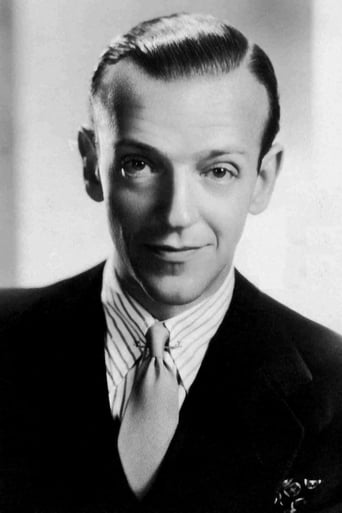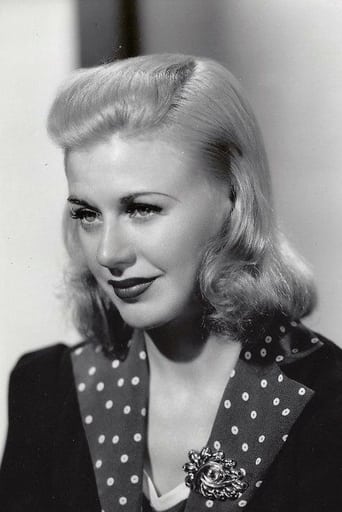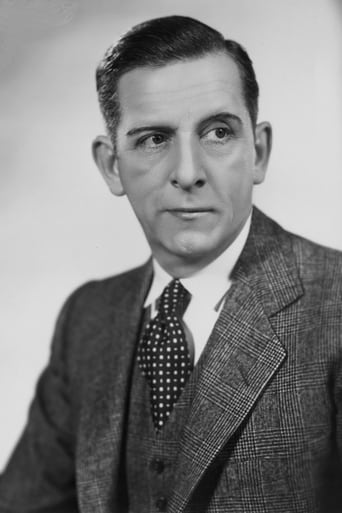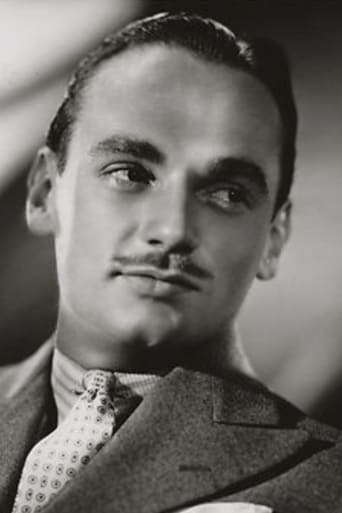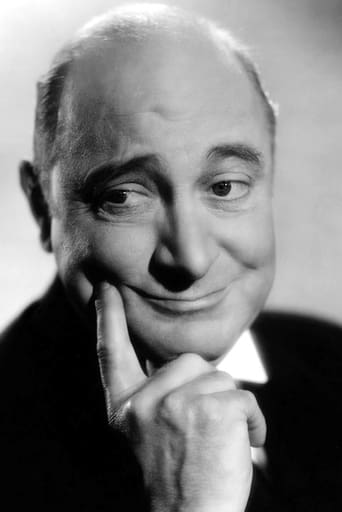Kattiera Nana
I think this is a new genre that they're all sort of working their way through it and haven't got all the kinks worked out yet but it's a genre that works for me.
Colibel
Terrible acting, screenplay and direction.
StyleSk8r
At first rather annoying in its heavy emphasis on reenactments, this movie ultimately proves fascinating, simply because the complicated, highly dramatic tale it tells still almost defies belief.
Alasdair Orr
Actress is magnificent and exudes a hypnotic screen presence in this affecting drama.
vert001
TOP HAT ranks high on practically everyone's 'Fred & Ginger' lists (including mine) probably because it's the most representative of their films. The audience gets everything it's expecting: a fabulous musical score from Irving Berlin, brilliant dancing, witty lines delivered by an expert supporting cast, spectacular Art Deco sets that virtually define that architectural and decorative movement, beautiful dresses for Ginger to wear including the most famous of them all, and probably Fred's most famous solo number. You even get the not- so-good that you expect, the basic farcical plot that's spurred on by a silly misunderstanding which goes on forever. Yes, TOP HAT has it all. Yet somehow I never look forward to re-watching it as I do most of the others. That's not to say that TOP HAT's elegance ever fails to delight me once I do begin to see it again. It does, always. But I never have the yearning to put it back in the old DVD player. I wonder why? By my reckoning, TOP HAT qualifies as a remake of THE GAY Divorcée, not quite as funny as the original and with a mistaken identity twist that goes on about three times as long, and seems to go on about 300 times as long, as that original's. On the plus side, and a powerful plus it is, TOP HAT has one more duet for Fred and Ginger than does TGD. As charming as it is to watch the youthful Betty Grable and Edward Everett Horton hoof it about, the gazebo dance is simply overwhelming in its impact (by comparison, check out the parody of this duet done by Eleanor Powell and George Murphy in one of their movies. It's very nice, but emotionally it comes and it goes to no lasting effect). Likewise, the brilliant 'No Strings' number may have given movies their finest 'meet cute' scene ever. If Astaire's tap dancing there doesn't lift your spirits I believe that you're probably dead already whether you realize it or not.The 'Cheek to Cheek' number is legendary, you don't need me going on about it. Our redheaded stepchild seems to be the poor Piccolino. True, its pseudo-Berkeley choral traipsing isn't much, and the song is just a bit of silly fun, but I find the celebratory dance done by Ginger and Fred to be perfect for the occasion. Not emotionally deep, the emotions having already been established, the Piccolino is simply joyous, just the sort of feeling that people ought to have at a wedding.TOP HAT was the peak of the ladder of Fred and Ginger's popularity. They'd gone from hit to big hit to huge hit to this mega hit. Now they would retrace those steps in practically the same order. It was a great climb up, and it's going to be a great climb down as well.
l_rawjalaurence
TOP HAT's musical score contains a remarkable number of standards - a testament to Irving Berlin's genius as a songwriter. They include "isn't This a Lovely Day?," "Cheek to Cheek," "No Strings," "The Piccolino," and the title song "Top Hat, White Tie and Tails." Just listening to the score is a joyful experience in itself.Mark Sandrich's film takes the elements that made THE GAY Divorcée of the year before so popular - a Hollywood English setting (to go with an Italian setting), a series of jokes at the expense of the stuffy Brits, and a supporting cast boasting Edward Everett Horton, Eric Blore and - and rehashes them into another memorable musical confection. The plot once again revolves around a comic misunderstanding involving Astaire, Everett Horton and Rogers, which leads to some amusing comic routines that normally end up with Everett Horton suffering in one way or another. He ends up with a black eye at one point. Yet the plot is not really significant: what matters are the song-and- dance sequences involving the two stars. They ooze style as they glide across the dance-floor, no more so than in "The Piccolino" sequence towards the end of the film. David Abel's camera sweeps across the set in a series of slow pans, that dissolve into aerial shots of the dancers accompanying the stars, and dissolve back once again into close-ups of Astaire and Rogers. The sequence creates a dream-world in which dancing is the only thing that matters.TOP HAT gives plenty of opportunities for comic relief that prove just how good Blore and Everett Horton actually are. Everett Horton is especially adept at the double-take as he continues a conversation until he realizes just what his interlocutor has actually said. He pauses, stares for a moment and then tries to continue the conversation, albeit haltingly. Blore's eyework is especially memorable: when engaged in one of his frequent arguments with Everett Horton, he has the habit of looking down at the ground and rolling his eyes, as if unable to fathom just what a chump his employer actually is. His most memorable moment comes in a sequence where he talks to an Italian police officer whom he thinks does not know English. He rolls his tongue round a series of gorgeous insults, but his mood abruptly changes when the officer replies to him in perfect English. He sighs, looks up at the sky, then from side to side, and reluctantly allows himself to be taken to prison.TOP HAT is perhaps the most shining example of a pre-1939 musical comedy, combining music, dance and routines in a wonderful soufflé. It is the kind of film that remains fresh and enjoyable even after repeated viewings.
Chris Mizerak
Once upon a time in the 1930's, a legendary pairing of two stars took place in the midst of the Great Depression. Keep in mind that this era was a trying time for America due to the fact that many people were either broke or starving to death. What made this pairing so special is that they helped many people forget for a brief period of time that they were living in such an era. That pairing is none other than that of Fred Astaire and Ginger Rogers. Though Astaire would later star in other memorable musicals such as "The Band Wagon" (1953) and narrate the Christmas special "Santa Claus Is Comin' To Town" (1970), this team was probably best known by many for their collaboration on musical-comedies such as "Swing Time" (1936) and "Top Hat" (1935), the latter being the subject of this very review. "Top Hat" follows American dancer Jerry Travers (Fred Astaire) who travels to London to do a show for producer Horace Hardwick (Edward Everett Horton). One night when practicing his dance routine in Hardwick's hotel room, a lady named Dale Tremont (Ginger Rogers) from the room below comes up to complain about the noise he's making. Immediately falling in love with Dale on their first meeting, Jerry is determined to pursue her all over town to win her affections. But things get complicated when Dale mistakes Jerry for Hardwick, who is married to Dale's friend Madge (Helen Broderick), and Dale gets engaged to Italian fashion designer Alberto Beddini (Erik Rhodes). So Jerry gets Hardwick and his butler Bates (Eric Blore) to help him with winning back Dale. Basically, the plot centers on a new couple that must try to clear up a big misunderstanding that has come between them. To be brutally honest, the plots have never been the primary strength of the musicals Astaire and Rogers made during that time. In fact, I can see why this story in particular might annoy moviegoers today as it's the type of plot found in rom-coms that most people hate. Because of the fact that the story centers on a misunderstanding, the couple apparently have to be convinced that they hate each other throughout most of the film (Though to be fair, I don't think Astaire hated Rogers at all). And as a result, we have trouble being convinced that they'd be a happy couple. Given that the ability to be convinced that a couple is in love is a crucial ingredient to make a romantic story work, the negative comments regarding the plot to "Top Hat" are justified in that sense. The story is awkward to say the least. But in terms of its execution, it could have been a lot worse. The aspects that truly sell the musicals starring Astaire and Rogers, especially this one, are the musical numbers and the dancing. Film critic Roger Ebert really opened my eyes in his Great Movies review of "Swing Time" regarding what made Astaire and Rogers stand out. Ebert stated that "Astaire believed every dance number should be filmed, as nearly as possible, in one unbroken take, always showing the full figures of the dancers from head to toes. There are no cutaways to an admiring audience--Astaire thought that was a distraction. No cuts, or very few, to different points of view. And no closeups of the dancer's faces, for that would deny us the movement of their bodies. When you see anyone--an athlete, a musician, a dancer, a craftsman--doing something difficult and making it look easy and a joy, you feel enhanced. It is a victory for the human side, over the enemies of clumsiness, timidity and exhaustion." To briefly summarize Ebert's brilliantly chosen words, Astaire and Rogers stood out from other talented dancers in Hollywood because they realized that little to no editing resulted in more convincing dancing. By using this minimal editing approach, we can truly appreciate the stamina and talent that Astaire and Rogers had as dancers and thus make the illusion seem more real to us. Remember the "Isn't It A Lovely Day" number early on in the film? The minimal editing used in that number captures the illusion that Rogers truly is progressing from a slow to fast dance alongside Astaire. As a result, the transformation of Rogers' character's opinion of Astaire's character during that song feels more complete. The dance sequences in the "Cheek to Cheek" and "Piccolino" musical numbers also obtain the illusion that they've been dancing for a certain period of time without interruptions. It's a smart strategy that Astaire and Rogers use for their dance sequences, so I give them full credit for that. Pet peeves with the narrative aside, Astaire and Rogers still have some likability to them. The exchange between them at the start of the picture (when Rogers complains about Astaire's noisy dancing) shows this teaming at their best and summarizes the chemistry between them in a nutshell. Rogers has some smart yet playful verbal jabs and Astaire always seems to maintain positivity even when the going gets tough (usually when certain people want him to go away). The songs by Irving Berlin stand the test of time, namely "Isn't It A Lovely Day", "Top Hat", "Cheek to Cheek" and "Piccolino". The dancing between our two leads is amazing because of how they maintain pleasure even under pressing circumstances (wardrobe troubles, hours and hours of rehearsal, etc.). "Top Hat" is the type of picture you don't see being made today. I wouldn't say that it's going to be for everybody in today's world. But considering the time it was made, it's nothing short of a miracle.
xboy614
This film will leave you screaming and dancing with delight! This film seriously reeks with class. Fred Astaire's character and Ginger Rodger's character are both extremely likable and cool. The dancing is truly amazing, you will suddenly feel very jealous of Mr Astaire after watching this movie. He makes everything look so easy when he dances. His voice seems really silky and soft when he sings and there is one Tap Dancing scene which will leave your tongue hanging out from your mouth. I must say first that this film is light. Don't bring your notebook out and start writing notes on the themes and ideas expressed through the movie, because you won't enjoy it. The plot is slight and over all a bit of nonsense. But it seems to take itself super seriously, but that, I think, is all part of the fun. There are only a few characters, they seem to breakthrough the stereotypes which is good. The art Deco style of London and the beauty of Venice is captured perfectly and I do get distracted sometimes by the background! I must say this, that this film is old. So, the camera shots are simpler, the acting isn't in your face and the film may feel a little slow, but this is part of the charm. There are only a handful of songs, sung by Astaire and Ginger, but they a good songs, including Cheek to Cheek and Top Hat, White tie and Tails. Great popcorn movie to enjoy with a girl or a family member!


